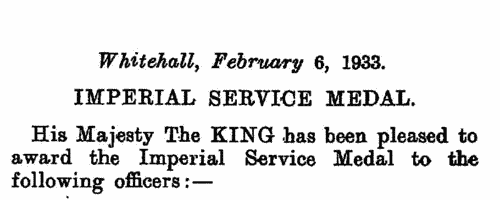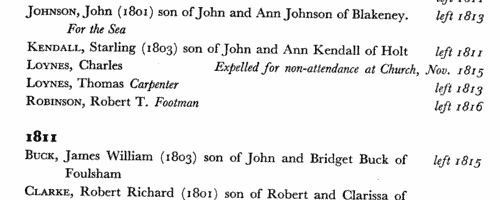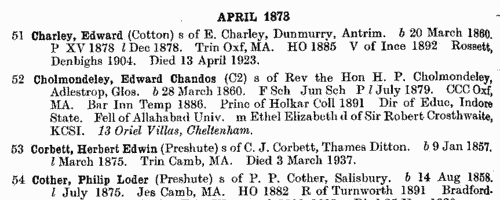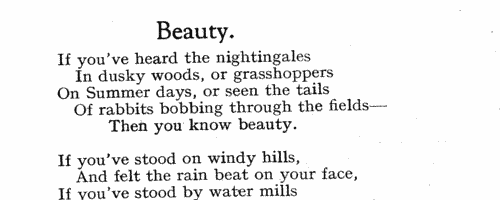Add this eBook to your basket to receive access to all 4,674 records. Our indexes include entries for the spelling king. In the period you have requested, we have the following 4,674 records (displaying 4,411 to 4,420): These sample scans are from the original record. You will get scans of the full pages or articles where the surname you searched for has been found. Your web browser may prevent the sample windows from opening; in this case please change your browser settings to allow pop-up windows from this site. Imperial Service Medal
(1932)
Awards by king George V of the Imperial Service Medal to officers of the Home Civil Service. The names are arranged alphabetically by surname and christian names, with office or rank in the service. | Sample scan, click to enlarge

| Scientific Poultry Breeders
(1932)
The Scientific Poultry Breeders Association was by far the largest poultry society in Great Britain, with 16,109 members for the year 1930-1931. This seventeenth annual register, for the year 1932, lists members alphabetically by surname and initials, with addresses. P. F. stands for Poultry Farm. | Sample scan, click to enlarge

| Boys entering Manchester Grammar School
(1933)
This Biographical Register of Old Mancunians lists boys alphabetically by year of entering the school. A bare register of entrants existed from 1888 onwards but it was only since the Second World War that any kind of detailed record was kept of those who passed through the school. So, in every case in this printed register, full name is given, in bold, surname first (in capitals); date of birth, and years attending the school; but for the earlier years sometimes there is no more information - or, equally, after investigation among Old Mancunians and published sources, the editors may have been able to furnish a condensed biography. An asterisk indicates a holder of a Foundation Scholarship. In the later years a current address is also given, as of 1964 to 1965, when the book was prepared. | Sample scan, click to enlarge

| Boys entering Marlborough College
(1933)
The public school at Marlborough in Wiltshire was founded in 1843. In 1952 this, 9th, edition of the college register was published, being a revision by L. Warwick James of the 8th edition (of 1936): but for the years before 1936 it does not merely repeat the 8th edition, because Warwick James was able to correct the 19th-century entries with information from newly-discovered letters and books from 1843 to 1853, and the school lists from 1844 onwards. The roll is arranged by year, and within each year by term of entrance, and then alphabetically by surname within each term. Each boy is assigned a number within the year: then his name is given, surname first, and, in brackets, his house. The houses within the college were called B1, B2, B3, C1, C2 and C3, and the Lower School (L Sch); the out college houses were Preshute, Priory, Cotton, Hermitage, Littlefield, Barton Hill, Summerfield and Upcot. Then there is given the boy's father's name (surname and initials) and address (at entrance), the boy's date of birth (b) and month of leaving (l). Where the boy represented the school at Rugby football (XV) or cricket (XI), in the rifle corps (VIII, or RC XI), that is indicated. There is a brief summary of achievements in later life, and, where known, and date of death or (in italics) address as in 1952. | Sample scan, click to enlarge

| Girls and Mistresses of Brownhills High School, Staffordshire
(1933)
Brownhills High School produced a yearly magazine, called Tunestallia, issued in July. Each issue had School Notes; poems and essays by current pupils; The Library (with names of recent donors); News of Old Staff; News of Old Girls - with marriages, and births of children; Parents' Association; School Societies; Old Girls' Association; The Four "Houses" (Blackbirds, Finches, Robins and Wrens); Games Report (Hockey, Netball, Rounders, Tennis, Swimming and Gymnastics); and Prizes (Form Prizes, Special Prizes, Certificates, Scholarships, the Bingham Games Cup) and lists of Prefects and Sub-Prefects.
| Sample scan, click to enlarge

| Imperial Service Medal
(1933)
Awards by king George V of the Imperial Service Medal to officers of the Home Civil Service. The names are arranged alphabetically by surname and christian names, with office or rank in the service. | Sample scan, click to enlarge

| Wives of Old Wellingtonians
(1933)
Wellington College, near Wokingham, was originally founded for the education of sons of military officers. A register of boys entering the school from First Term 1859 to Michaelmas 1933 was compiled by F. G. Lawrence for the Old Wellingtonian Society. In each entry the boy's name is given in full, in bold, surname first; age at entry (usually 11 to 14); then, in brackets, the name of the dormitory or house to which he belonged, in italics, with the years of his stay; then his father's name (usually surname and initials, but not christian name) with military decorations where appropriate. School prefects and captains are noted as such; if the boy played cricket for the school, XI with the years; academic honours, scholarships, &c.; a brief biography; and date of death, or (where known) address in 1933. Year of marriage is given, and sometimes the wife's name and/or her father's name. Clearly, those boys who kept contact with the school and/or had distinguished military careers have detailed entries; others disappeared into oblivion on leaving. This is the index to the maiden names of the wives, who may or may not have survived to 1933. | Sample scan, click to enlarge

| Boys entering Gresham's School
(1934)
The Sir John Gresham Grammar School at Holt in Norfolk was founded by sir John, who bought the manor house there in 1546 to convert it into a school, and building work had started by 1555. To celebrate the quatercentenary in 1955, a history of the school written by the Reverend C. L. S. Linnell was published, together with an Alumni Greshamienses, a register of boys entering the school from 1562 to 1954, compiled by A. B. Douglas. The materials to hand for the register for the early years were slight; the first coherent lists of boys survive only from 1729, and then are fitful, with little detail, and largely missing from 1784 to 1803; however, from 1810 onwards the names of boys' parents are usually recorded. The register is arranged chronologically by year (and from 1900 by term - L, Lent; M, Michaelmas; S, Summer), and then alphabetically by surname (in capitals) and christian name(s). Where known, year of birth is then given (in brackets), names, addresses and occupations of parents. From 1900 onwards there are italic abbreviations for sporting achievements at school (h, hockey colours; VIII, shooting colours; S, first-class swimmer; XI, cricket colours; XV, football colours), and p for house prefect and P for school prefect; then (in italics) information about the boy's adult life, and his address (where living) at the time of publication. Finally, on the right hand side of the page, in italics, is given the year of his leaving the school. Most detail is absent before 1810; and, of course, for the boys still at school in 1955, or only recently left, there are no details of future career; nor are there the usual details about their parentage. From 1898 onwards day boys are noted with an italic D (N means Newquay dayboy); and from 1900 onwards the school houses are shown (B, Bengal Lodge; F, Farfield; H, School House or Howson's; K, Kenwyn; O, Old School House; W, Woodlands); and, for the junior school, c, Crossways; k, Kenwyn; o, Old School House). | Sample scan, click to enlarge

| Boys entering Marlborough College
(1934)
The public school at Marlborough in Wiltshire was founded in 1843. In 1952 this, 9th, edition of the college register was published, being a revision by L. Warwick James of the 8th edition (of 1936): but for the years before 1936 it does not merely repeat the 8th edition, because Warwick James was able to correct the 19th-century entries with information from newly-discovered letters and books from 1843 to 1853, and the school lists from 1844 onwards. The roll is arranged by year, and within each year by term of entrance, and then alphabetically by surname within each term. Each boy is assigned a number within the year: then his name is given, surname first, and, in brackets, his house. The houses within the college were called B1, B2, B3, C1, C2 and C3, and the Lower School (L Sch); the out college houses were Preshute, Priory, Cotton, Hermitage, Littlefield, Barton Hill, Summerfield and Upcot. Then there is given the boy's father's name (surname and initials) and address (at entrance), the boy's date of birth (b) and month of leaving (l). Where the boy represented the school at Rugby football (XV) or cricket (XI), in the rifle corps (VIII, or RC XI), that is indicated. There is a brief summary of achievements in later life, and, where known, and date of death or (in italics) address as in 1952. | Sample scan, click to enlarge

| Girls and Mistresses of Brownhills High School, Staffordshire
(1934)
Brownhills High School produced a yearly magazine, called Tunestallia, issued in July. Each issue had School Notes; poems and essays by current pupils; The Library (with names of recent donors); News of Old Staff; News of Old Girls - with marriages, and births of children; Parents' Association; School Societies; Old Girls' Association; The Four "Houses" (Blackbirds, Finches, Robins and Wrens); Games Report (Hockey, Netball, Rounders, Tennis, Swimming and Gymnastics); and Prizes (Form Prizes, Special Prizes, Certificates, Scholarships, the Bingham Games Cup) and lists of Prefects and Sub-Prefects.
| Sample scan, click to enlarge

|
Research your ancestry, family history, genealogy and one-name study by direct access to original records and archives indexed by surname.
|











